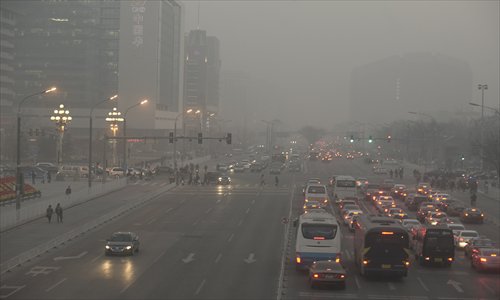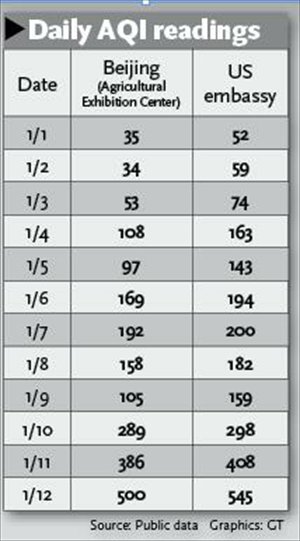Chinese, US Air Quality Index not the same


As Beijing chokes on its worst air pollution on record, observers may have noticed that the numbers from the city's new Air Quality Index are consistently lower than the numbers released by the US embassy.
However, Chinese experts say that this discrepancy was expected, because the Beijing Environmental Monitoring Center is using a slightly different method to calculate the index, which it started publishing on January 1. In addition, the scale the Chinese are using stops at 500, while the US embassy is publishing higher readings.
It is difficult to compare the US embassy and Beijing Environmental Monitoring Center's measurements of PM2.5, deadly fine particulate matter that is one component of air pollution measured by the AQI. The center does not keep a record online, but only shows the reading for the current hour. A spokesperson refused to give the data to the Global Times, referring the reporter to the website.
At 3 pm Sunday the PM2.5 reading at the center's Agricultural Exhibition Center was 271, compared to a reading of 323 at the US embassy, about 1.5 kilometers away. At 7 pm, the reading was 290, compared to 343 at the US embassy. The environmental monitoring center uses 35 stations around the greater metropolitan area to gather pollution data, with both higher and lower readings than the embassy's.
Questions about how the government measures air pollution are deadly serious. A study by Peking University and environmental NGO Greenpeace published last month says air pollution led to 2,349 deaths in Beijing in 2010, and the authors expect deaths in 2012 to reach 2,589 if the pollution level doesn't change. In 2007, a scientist complained that a World Bank report omitted data that found 750,000 people die prematurely across China from pollution.
Qiu Qihong, an engineer of the Beijing Environmental Monitoring Center, said US and China use the same function to determine AQI figures from six different pollutants. However, he explained that the UStates uses a stricter system to determine what numbers to plug into the AQI formula. The formula requires a range of values of PM2.5 to calculate the number, and the US and China are using different ways to determine this range.
Qiu explained, "The US uses a stricter system because their society is further along in the industrialization process."
This is why when PM2.5 density is transferred to AQI figures, the two countries have different readings, Qiu said.
For example, according to the standards published by both countries, if the PM2.5 density reaches 15.4 micrograms per cubic meter, according to US standards, the matching AQI figure is 50. But under Chinese standards, the density needs to reach 35 micrograms per cubic meter.
Zhou Rong, climate and energy director of Greenpeace, said there might be a small difference between the figures and it shouldn't raise serious questions. She also supplied another reason for the value difference.
"There are two steps of getting the AQI values. First you need equipment to measure PM2.5 density in the air, and the technical standards are different between US and China, so there might be a data deviation," she said.
The NGO Green Beagle, frustrated with a lack of transparency by the government, started training citizens how to collect their own PM2.5 data in 2011. He Xiaoxia, a representative of the group, said the group could not provide its own data to compare to the government's own data.
"We don't have data these few days, we'll have it in a couple of days. But the Beijing Environmental Monitoring Center has been updating their data. As of now we can only trust their data, the center has professional equipment and monitors in professional ways, it must be expert, why not trust their data? Our data, on the other hand, is only for reference."
Zhou from Greenpeace praised the authorities' decision to release PM2.5 data as a big improvement in air quality monitoring.
She doesn't question the data, but notes there are still issues to be dealt with.
"The problem is now we have the data, the real diagnosis, how do we improve the situation. That hasn't been brought up completely on the local government's agenda," she said.
The government did set a goal, but it's unlikely to reach it. In early December, the Ministry of Environmental Protection announced there should be a reduction of 6 percent in the level of PM2.5 pollution in Beijing.
In December, Zhou told the Global Times the goal of a 6 percent reduction might not be attainable, saying, "Given the harsh fact that the average annual intensity of PM2.5 particles in most Chinese cities always exceeds the national standards, the expectation of improving air quality by 6 percent is still elusive."
"The next step is to open up to the public on how to control the pollution, timeline and standards," she said.
Beijing's new Air Quality Index that came into effect on January 1 replaces an opaque system put into place last year that measured PM2.5 using a scale that was hard to understand.
The goal of the new AQI was to make air pollution readings more transparent. It came after years of refusing to measure PM2.5, hiding the true extent of air pollution.
Efforts by the Global Times to determine how the authorities calculate the AQI have been stonewalled by environmental officials at the Beijing Environmental Protection Bureau and Ministry of Environmental Protection.
On Sunday, Qiu directed the Global Times to a report called "Technical Regulation on Ambient Air Quality Index (on trial)," detailing how the index is calculated, on the official site for the China National Environmental Monitoring Center.
Qiu also explained why the index stops at 500.
"We consulted the standard in US and Europe when making the Chinese one. The American scale also stops at 500 according to standard, because 500 is a pretty high ceiling and can't be reached."
Qiu noted, "According to standard, the US embassy should only publish 'above 500' and not an actual number." On Saturday the center's daily reading was 500, and the US embassy's daily reading was 545. The embassy's hourly readings topped out at 886.